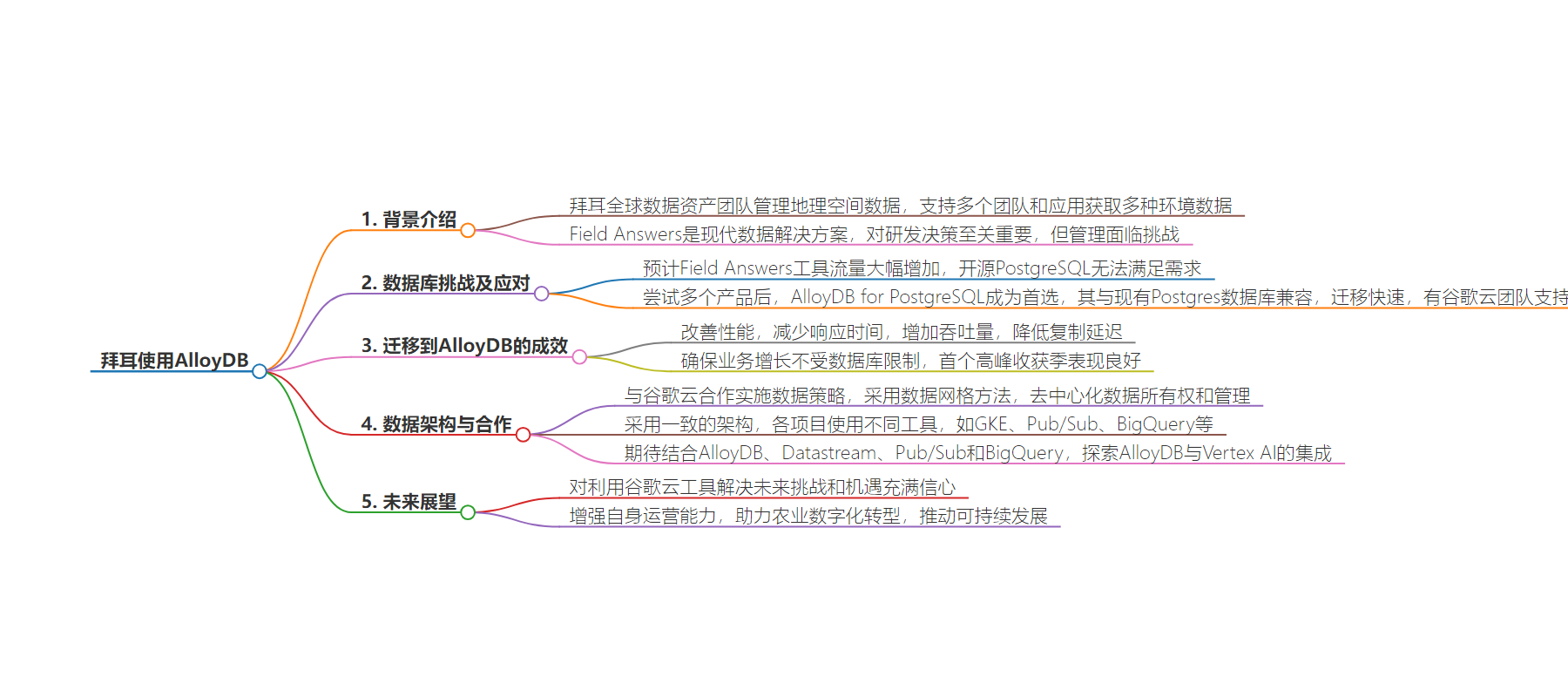包阅导读总结
1. `Bayer`、`AlloyDB`、`Google Cloud`、`Data Architecture`、`Farming Innovation`
2. 本文讲述了拜耳公司在农业数据管理中面临挑战,选择迁移到 AlloyDB 以应对流量增长,获得性能提升,并与谷歌云合作构建数据架构,展望未来集成与创新,以推动农业的数字化转型。
3.
– 拜耳公司的全球数据资产团队管理农业相关的地理空间数据,其 Field Answers 解决方案对研发决策至关重要。
– 准备接纳新市场时,预计工具流量大增,原开源 PostgreSQL 无法满足需求。
– 经过测试,AlloyDB 成为首选,因其与现有数据库兼容,迁移顺利。
– 迁移到 AlloyDB 后业务变革显著,性能大幅提升,满足需求并减少复制延迟。
– 其架构减少了读取流量扩展的影响,在负载测试中表现出色。
– 与谷歌云合作实施数据策略,采用一致架构。
– 包括 GKE 托管的 Pods 等,数据存储在 BigQuery 等。
– 展望未来,期待工具集成,探索新机会,增强运营能力,为农业数字化转型做贡献。
思维导图:
文章地址:https://cloud.google.com/blog/products/databases/bayer-uses-alloydb/
文章来源:cloud.google.com
作者:Aaron Joyce
发布时间:2024/7/10 0:00
语言:英文
总字数:920字
预计阅读时间:4分钟
评分:90分
标签:数据库迁移,AlloyDB for PostgreSQL,农业技术,谷歌云,数据管理
以下为原文内容
本内容来源于用户推荐转载,旨在分享知识与观点,如有侵权请联系删除 联系邮箱 media@ilingban.com
Bayer uses the power of science to shape the future of farming. Our Global Data Assets team manages geospatial data for the company. We support hundreds of teams and applications with access to maps, phenotypic observations (observed physical characteristics of a plant), satellite imagery, and other environmental data like weather and soil strata.
Field Answers is a modern data solution we created to efficiently collect and compute billions of observations across field and greenhouse operations globally. This data is vital for the decisions made at various stages in our research and development (R&D) pipelines, including choosing the best seeds, optimizing the costs of production, and marketing our products to farmers. However, managing such a large-scale system presents its own challenges.
Weeding out database challenges
As we prepared to onboard a new market segment to Field Answers, we anticipated a dramatic increase in traffic to the tool. Field Answers is a distributed solution, and its sensitivity to order and replication lag can affect its performance. Based on extensive load testing, we knew our open-source PostgreSQL setup would not be able to meet latency and throughput demands. This would reduce access to the valuable datasets our teams require.
We needed a new database, and we needed it fast. After trying multiple products, AlloyDB for PostgreSQL emerged as our top choice. We received consistent support from the Google Cloud team as we tested AlloyDB, which assured us they would be there in case of any unforeseen migration issues. Because it was compatible with our existing Postgres database, we could migrate with zero application changes and hit our aggressive migration timelines. With the North American agricultural planting season just around the corner, that compatibility was huge!
Harvesting growth with AlloyDB
Migrating to AlloyDB has been transformative for our business. In our previous PostgreSQL setup, the primary writer was responsible for both write operations and replicating those changes to reader nodes. The anticipated increase in write traffic and reader count would have overwhelmed this node, leading to potential bottlenecks and increased replication lag. AlloyDB’s architecture, which utilizes a single source of truth for all nodes, significantly reduced the impact of scaling read traffic. After migrating, we saw a dramatic improvement in performance, ensuring our ability to meet growing demands and maintain consistently low replication delay. In parallel load tests, a smaller AlloyDB instance reduced response times by over 50% on average and increased throughput by 5x compared to our previous PostgreSQL solution.
By migrating to AlloyDB, we’ve ensured that our business growth won’t be hindered by database limitations, allowing us to focus on innovation. The true test of our migration came during our first peak harvest season, a time where performance is critical for product decision timelines. Due to agriculture’s seasonal nature, a delay of just a few days can postpone a product launch by an entire year. Our customers were understandably nervous, but thanks to Google Cloud and AlloyDB, the harvest season went as smoothly as we could have hoped for.
Cultivating a thriving data architecture
Partnering with Google Cloud has played a crucial role in implementing our data strategy, an adaptation of the data mesh approach where each asset serves a particular data domain. This approach allows us to decentralize data ownership and management, enabling domain-driven teams to take responsibility for their data while ensuring quality, accessibility, and governance.
To support our data strategy, we have adopted a consistent architecture across our Google Cloud projects. For a typical project, the stack consists of Google Kubernetes Engine (GKE) hosted pods and pipelines for publishing events and analytics data. While Bayer uses Apache Kafka across teams and cloud providers for data streaming, individual teams regularly use Pub/Sub internally for messaging and event-driven architectures. Data for analytics and reporting is generally stored in BigQuery, with custom processes for materialization once it lands. By using cross-project BigQuery datasets, we are able to work with a larger, real-time user group and enhance our operational capabilities.
Nurturing innovation through collaboration
Looking ahead, we’re excited about the potential to combine AlloyDB, Datastream, Pub/Sub, and BigQuery. With the built-in integrations between these tools, we see opportunities to reduce toil, increase reliability, and scale our applications more effectively. We’re also eager to explore AlloyDB’s integration with Vertex AI, which could open up new opportunities to use machine learning and advanced analytics.
As we continue our journey with Google Cloud, we’re confident we have the right tools to tackle the challenges and opportunities that lie ahead. By leveraging the power of AlloyDB and the Google Cloud ecosystem, we’re not only enhancing our own operational capabilities but also contributing to the future of farming. With more efficient and innovative solutions, we can help farmers make data-driven decisions, optimize their operations, and ultimately, feed the world more sustainably. The future of agriculture is digital, and we’re proud to be at the forefront of this transformation with Google Cloud by our side.
Next steps
